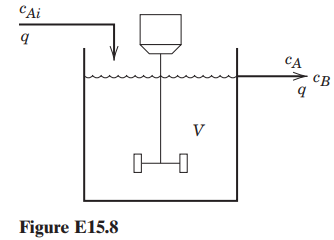A liquid-phase reversible reaction, A B, takes place isothermally in the continuous stirred-tank reactor shown in Fig.
Question:
![moles of A reacting (time) (volume) -ra = k,cA – k,Cg, ľA [=]](https://dsd5zvtm8ll6.cloudfront.net/si.question.images/images/question_images/1533/6/3/8/1385b6975fa387a71533620388738.jpg)
The control objective is to control exit concentration cB by manipulating volumetric flow rate, q. The chief disturbance variable is feed concentration cAi. It can be measured on-line, but the exit stream composition cannot. The control valve and sensor-transmitter have negligible dynamics and positive steady-state gains

(a) Design a feedforward controller based on a dynamic model.
(b) If the exit concentration cB could be measured and used or feedback control, should this feedback controller be reverse- or direct-acting?
(c) Is dynamic compensation necessary?
Fantastic news! We've Found the answer you've been seeking!
Step by Step Answer:
Related Book For 

Process Dynamics And Control
ISBN: 1602
4th Edition
Authors: Dale E. Seborg, Thomas F. Edgar, Duncan A. Mellichamp, Francis J. Doyle
Question Posted:





